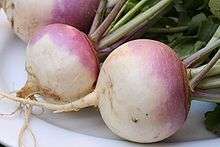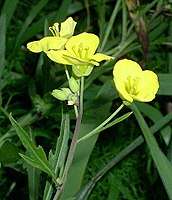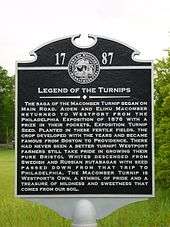Turnip
The turnip or white turnip (Brassica rapa subsp. rapa) is a root vegetable commonly grown in temperate climates worldwide for its white, fleshy taproot. The word turnip is a compound of tur- as in turned/rounded on a lathe and neep, derived from Latin napus, the word for the plant. Small, tender varieties are grown for human consumption, while larger varieties are grown as feed for livestock. In the north of England, Scotland, Ireland, Cornwall and eastern Canada (Newfoundland and the Maritimes), turnip (or neep) often refers to rutabaga, a larger, yellow root vegetable in the same genus (Brassica) also known as swede (from "Swedish turnip").[1]
| Turnip | |
|---|---|
 | |
| Turnip roots | |
| Scientific classification | |
| Kingdom: | Plantae |
| (unranked): | |
| (unranked): | |
| (unranked): | |
| Order: | Brassicales |
| Family: | Brassicaceae |
| Genus: | Brassica |
| Species: | B. rapa |
| Variety: | B. rapa var. rapa |
| Trinomial name | |
| Brassica rapa var. rapa | |
Description
The most common type of turnip is mostly white-skinned apart from the upper 1–6 centimetres (0.39–2.36 in), which protrude above the ground and are purple or red or greenish where the sun has hit. This above-ground part develops from stem tissue, but is fused with the root. The interior flesh is entirely white. The root is roughly globular, from 5–20 centimetres (2.0–7.9 in) in diameter, and lacks side roots. Underneath, the taproot (the normal root below the swollen storage root) is thin and 10 centimetres (3.9 in) or more in length; it is often trimmed off before the vegetable is sold. The leaves grow directly from the above-ground shoulder of the root, with little or no visible crown or neck (as found in rutabagas).
Turnip leaves are sometimes eaten as "turnip greens" ("turnip tops" in the UK), and they resemble mustard greens (to which they are closely related) in flavor. Turnip greens are a common side dish in southeastern U.S. cooking, primarily during late fall and winter. Smaller leaves are preferred, but the bitter taste of larger leaves can be reduced by pouring off the water from the initial boiling and replacing it with fresh water. Varieties of turnip grown specifically for their leaves resemble mustard greens and have small or no storage roots. These include rapini (broccoli rabe), bok choy, and Chinese cabbage. Similar to raw cabbage or radish, turnip leaves and roots have a pungent flavor that becomes milder after cooking.
Turnip roots weigh up to 1 kilogram (2.2 lb), although they are usually harvested when smaller. Size is partly a function of variety and partly a function of the length of time the turnip has grown. Most very small turnips (also called baby turnips) are specialty varieties. These are only available when freshly harvested and do not keep well. Most baby turnips can be eaten whole, including their leaves. Baby turnips are sold in yellow-, orange-, and red-fleshed varieties, as well as white-fleshed. Their flavor is mild, so they can be eaten raw in salads like radishes and other vegetables.
Nutrition
| Nutritional value per 100 g (3.5 oz) | |
|---|---|
| Energy | 84 kJ (20 kcal) |
4.4 g | |
| Sugars | 0.5 g |
| Dietary fiber | 3.5 g |
0.2 g | |
1.1 g | |
| Vitamins | Quantity %DV† |
| Vitamin A equiv. | 48% 381 μg42% 4575 μg |
| Thiamine (B1) | 4% 0.045 mg |
| Riboflavin (B2) | 6% 0.072 mg |
| Niacin (B3) | 3% 0.411 mg |
| Pantothenic acid (B5) | 5% 0.274 mg |
| Vitamin B6 | 14% 0.18 mg |
| Folate (B9) | 30% 118 μg |
| Vitamin C | 33% 27.4 mg |
| Vitamin E | 13% 1.88 mg |
| Vitamin K | 350% 368 μg |
| Minerals | Quantity %DV† |
| Calcium | 14% 137 mg |
| Iron | 6% 0.8 mg |
| Magnesium | 6% 22 mg |
| Manganese | 16% 0.337 mg |
| Phosphorus | 4% 29 mg |
| Potassium | 4% 203 mg |
| Sodium | 2% 29 mg |
| Other constituents | Quantity |
| Water | 93.2 g |
| Lutein | 8440 µg |
| |
| †Percentages are roughly approximated using US recommendations for adults. Source: USDA Nutrient Database | |
| Nutritional value per 100 g (3.5 oz) | |
|---|---|
| Energy | 92 kJ (22 kcal) |
5.1 g | |
| Sugars | 3.0 |
| Dietary fiber | 2.0 g |
0.1 g | |
0.7 g | |
| Vitamins | Quantity %DV† |
| Thiamine (B1) | 2% .027 mg |
| Riboflavin (B2) | 2% .023 mg |
| Niacin (B3) | 2% .299 mg |
| Pantothenic acid (B5) | 3% .142 mg |
| Vitamin B6 | 5% .067 mg |
| Folate (B9) | 2% 9 μg |
| Vitamin C | 14% 11.6 mg |
| Minerals | Quantity %DV† |
| Calcium | 3% 33 mg |
| Iron | 1% .18 mg |
| Magnesium | 3% 9 mg |
| Manganese | 3% .071 mg |
| Phosphorus | 4% 26 mg |
| Potassium | 4% 177 mg |
| Sodium | 1% 16 mg |
| Zinc | 1% .12 mg |
| Other constituents | Quantity |
| Water | 93.6 g |
| |
| †Percentages are roughly approximated using US recommendations for adults. Source: USDA Nutrient Database | |
Boiled green leaves of the turnip top ("turnip greens") provide 20 calories in a 100 gram amount, and are 93% water, 4% carbohydrates, and 1% protein, with negligible fat (table). The boiled greens are a rich source (more than 20% of the Daily Value, DV) particularly of vitamin K (350% DV), with vitamin A, vitamin C, and folate also in significant content (30% DV or greater, table). Boiled turnip greens also contain substantial lutein (8440 micrograms per 100 g).
In a 100 gram reference amount, boiled turnip root supplies 22 calories, with only vitamin C in a moderate amount (14% DV). Other micronutrients in boiled turnip are in low or negligible content (table). Boiled turnip is 94% water, 5% carbohydrates, and 1% protein, with negligible fat.
Origin
Some evidence shows the turnip was domesticated before the 15th century BC; it was grown in India at this time for its oil-bearing seeds.[2] The turnip was a well-established crop in Hellenistic and Roman times, which leads to the assumption that it was brought into cultivation earlier. Sappho, a Greek poet from the seventh century BC, calls one of her paramours Gongýla, "turnip". Zohary and Hopf note, however, "there are almost no archaeological records available" to help determine its earlier history and domestication. Wild forms of the hot turnip and its relatives the mustards and radishes are found over west Asia and Europe, suggesting their domestication took place somewhere in that area. However, Zohary and Hopf conclude, "Suggestions as to the origins of these plants are necessarily based on linguistic considerations."[3]
Cultivation
The 1881 American Household Cyclopedia advises that turnips can be grown in fields that have been harrowed, ploughed, and planted with turnip seed. It recommends planting in late May or June and weeding and thinning with a hoe throughout the summer.[4]
As a root crop, turnips grow best in cool weather; hot temperatures cause the roots to become woody and bad-tasting. They are typically planted in the spring in cold-weather climates (such as the northern US and Canada) where the growing season is only 3–4 months. In temperate climates (ones with a growing season of 5–6 months), turnips may also be planted in late summer for a second fall crop. In warm-weather climates (7 or more month growing season), they are planted in the fall. 55–60 days is the average time from planting to harvest.
Turnips are a biennial plant, taking two years from germination to reproduction. The root spends the first year growing and storing nutrients, and the second year flowers, produces seeds, and dies. The flowers of the turnip are tall and yellow, with the seeds forming in pea-like pods. In areas with less than seven-month growing seasons, temperatures are too cold for the roots to survive the winter. To produce seeds, pulling the turnips and storing them over winter is necessary, taking care not to damage the leaves. During the spring, they may be set back in the ground to complete their lifecycle.
 Turnip (flower)
Turnip (flower) A bundle of Tokyo turnips
A bundle of Tokyo turnips
Human use

In England around 1700, Turnip Townshend promoted the use of turnips in a four-year crop-rotation system that enabled year-round livestock feeding.[5] In most of England, the smaller white vegetables are called turnips, while the larger yellow ones are referred to as swedes. In the United States, turnips are the same, but swedes are usually called rutabagas. Neeps (turnips) are mashed and eaten with haggis, traditionally on Burns Night.[6]
Turnips are carved out as lanterns for Halloween festivals in the Isle of Man, Ireland and Scotland.[7][8] At Halloween in Scotland in 1895, masqueraders in disguise carried lanterns made out of scooped-out turnips.[9]
Heraldry
The turnip is an old vegetable charge in heraldry. It was used by Leonhard von Keutschach, prince-archbishop of Salzburg. The turnip is still the heart shield in the arms of Keutschach am See.
The arms of the former municipality of Kiikala, Finland, were Gules, a turnip Or.
See also
- Daikon
- DCPA, a commonly used herbicide in the growing of turnips
- Kohlrabi, aka "German turnip"
- Celeriac, aka "turnip-rooted celery"
- Nanakusa-no-sekku
- Turnip Prize
- Turnip Winter
References
- Smillie, Susan (25 January 2010). "Are 'neeps' swedes or turnips?". The Guardian.
- "Turnip – Brassica Rapa". Self Sufficientish. Retrieved 14 January 2013.
- Zohary, Daniel; Hopf, Maria; Weiss, Ehud (2012). Domestication of plants in the Old World : the origin and spread of domesticated plants in Southwest Asia, Europe, and the Mediterranean Basin (4th ed.). Oxford: Oxford University Press. p. 139. ISBN 9780199549061.
- https://archive.org/details/Household_Cyclopedia
- Ashton, T S (1948). The Industrial Revolution. A Galaxy Book (Third printing, 1965 ed.). New York: Oxford University Press. p. 21.
- Smillie, Susan (2010-01-25). "Are 'neeps' swedes or turnips?". The Guardian.
- The Oxford companion to American food and drink p.269. Oxford University Press, 2007. Retrieved February 17, 2011
- Arnold, Bettina (2001-10-31). "Bettina Arnold – Halloween Lecture: Halloween Customs in the Celtic World". Halloween Inaugural Celebration. University of Wisconsin–Milwaukee: Center for Celtic Studies. Retrieved 2007-10-16.
- Leslie, Frank (November 1895). "Frank Leslie's Popular Monthly". google.com. p. 540.
External links
| Wikibooks Cookbook has a recipe/module on |
| Wikimedia Commons has media related to Brassica rapa subsp. rapa. |